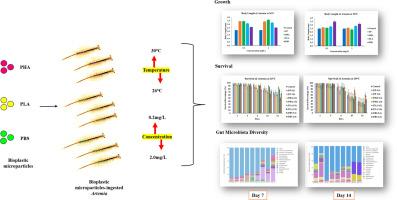Bioplastic microparticles exposure on brine shrimp, Artemia franciscana and the effects on survival, growth and intestinal microbiota composition
IF 7.4
2区 化学
Q1 POLYMER SCIENCE
引用次数: 0
Abstract
Bioplastics are considered a greener alternative to conventional plastics and mitigate environmental pollution caused by mismanaged plastic waste. Although there is a tendency toward greater use of bioplastics, the extent to which they may accumulate in marine environments and organisms, and their potential impact remains unknown. Therefore, this study assessed the induced accumulation of irregular and non-homogenous bioplastic microparticles (polyhydroxyalkanoate (PHA), polylactic acid (PLA), and polybutylene succinate (PBS)) in brine shrimp (Artemia franciscana) at two concentrations (0.2 and 2.0 mg/L) and temperatures (26 °C and 30 °C) for 14 days. Overall, exposure to different types of bioplastics did not significantly impact the growth and survival of Artemia but was significantly affected by temperature and concentration. The growth of Artemia was significantly decreased at 30 °C compared to 26 °C. Meanwhile, the survival showed a significant difference between the concentrations of bioplastics exposure showing a higher survival percentage at 0.2 mg/L. Bacterial 16S rRNA gene sequencing revealed that the dominance of phyla of gut microbiota across all samples and time points were Proteobacteria, Actinobacteria, and Cyanobacteria. The α-diversity across the treatments indicates the gut microbial composition underwent microbial shifts over time and might be influenced by bioplastic microparticles. This study suggests that there may be a combined adverse impact of bioplastic microparticles and temperature that can be seen in the growth, survival, and gut microbiota modulation. This study provides a preliminary understanding of the effect of bioplastic microparticles combined with temperature on marine organisms that shows a different perspective of bioplastics.

生物塑料微粒暴露于卤对虾、白耳蒿及其对其生存、生长和肠道菌群组成的影响
生物塑料被认为是传统塑料的绿色替代品,可以减轻塑料废物管理不善造成的环境污染。虽然有更多使用生物塑料的趋势,但它们在海洋环境和生物中可能积聚的程度及其潜在影响仍然未知。因此,本研究评估了在两种浓度(0.2和2.0 mg/L)和温度(26°C和30°C)下14天诱导的不规则和非均质生物塑料微粒(聚羟基烷酸酯(PHA)、聚乳酸(PLA)和聚丁二烯丁二酸酯(PBS))在卤虾(Artemia franciscana)体内的积累。总体而言,暴露于不同类型的生物塑料对蒿的生长和存活没有显著影响,但温度和浓度对蒿的生长和存活有显著影响。与26°C相比,30°C时蒿的生长明显下降。与此同时,不同生物塑料暴露浓度间的存活率存在显著差异,在0.2 mg/L时存活率较高。细菌16S rRNA基因测序显示,在所有样品和时间点上,肠道微生物群的优势门是变形菌门、放线菌门和蓝藻门。不同处理的α-多样性表明肠道微生物组成随着时间的推移发生了变化,可能受到生物塑料微粒的影响。这项研究表明,生物塑料微粒和温度可能在生长、生存和肠道微生物群调节中存在共同的不利影响。本研究提供了生物塑料微粒与温度结合对海洋生物影响的初步认识,展示了生物塑料的不同视角。
本文章由计算机程序翻译,如有差异,请以英文原文为准。
求助全文
约1分钟内获得全文
求助全文
来源期刊

Polymer Degradation and Stability
化学-高分子科学
CiteScore
10.10
自引率
10.20%
发文量
325
审稿时长
23 days
期刊介绍:
Polymer Degradation and Stability deals with the degradation reactions and their control which are a major preoccupation of practitioners of the many and diverse aspects of modern polymer technology.
Deteriorative reactions occur during processing, when polymers are subjected to heat, oxygen and mechanical stress, and during the useful life of the materials when oxygen and sunlight are the most important degradative agencies. In more specialised applications, degradation may be induced by high energy radiation, ozone, atmospheric pollutants, mechanical stress, biological action, hydrolysis and many other influences. The mechanisms of these reactions and stabilisation processes must be understood if the technology and application of polymers are to continue to advance. The reporting of investigations of this kind is therefore a major function of this journal.
However there are also new developments in polymer technology in which degradation processes find positive applications. For example, photodegradable plastics are now available, the recycling of polymeric products will become increasingly important, degradation and combustion studies are involved in the definition of the fire hazards which are associated with polymeric materials and the microelectronics industry is vitally dependent upon polymer degradation in the manufacture of its circuitry. Polymer properties may also be improved by processes like curing and grafting, the chemistry of which can be closely related to that which causes physical deterioration in other circumstances.
 求助内容:
求助内容: 应助结果提醒方式:
应助结果提醒方式:


